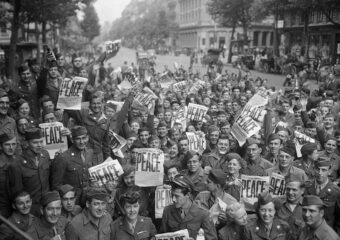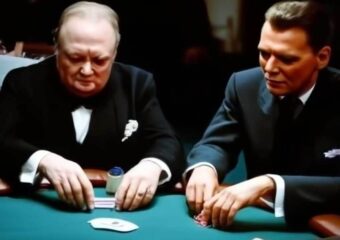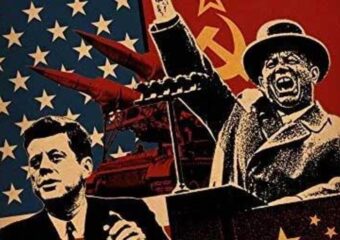
The swastika (卐) (Sanskrit: स्वस्तिक) is an equilateral cross with four arms bent at 90 degrees. The earliest archaeological evidence of swastika-shaped ornaments dates back to the Indus Valley Civilization as well as the Mediterranean Classical Antiquity. Swastikas have also been used in various other ancient civilizations around the world including China, Japan, India, and Southern Europe. It remains widely used in Indian religions, specifically in Hinduism, Buddhism, and Jainism, primarily as a tantric symbol to evoke shakti or the sacred symbol of auspiciousness. The word “swastika” comes from the Sanskrit svastika – “su” meaning “good” or “auspicious,” “asti” meaning “to be,” and “ka” as a suffix. The swastika literally means “to be good”. Or another translation can be made: “swa” is “higher self”, “asti” meaning “being”, and “ka” as a suffix, so the translation can be interpreted as “being with higher self”.
The symbol has a long history in Europe reaching back to antiquity. In modern times, following a brief surge of popularity as a good luck symbol in Western culture, a swastika was adopted as a symbol of the Nazi Party of Germany in 1920, who used the swastika as a symbol of the Aryan race. After Adolf Hitler came to power in 1933, a right-facing 45° rotated swastika was incorporated into the Nazi party flag, which was made the state flag of Germany during Nazism. Hence, the swastika has become strongly associated with Nazism and related ideologies such as anti-Semitism, hate, violence, death, and murder in many countries, and is now largely stigmatized there due to the changed connotations of the symbol. Notably, it has been outlawed in Germany and other countries if used as a symbol of Nazism in certain instances. Many modern political extremists and Neo-Nazi groups such as the Russian National Unity use stylized swastikas or similar symbols.
In the Baltic region the swastika is one of the most common symbols used throughout Baltic art. In Latvian the symbol is known as either Ugunskrusts, the “Fire cross” (rotating counter-clockwise), or Pērkonkrusts, the “Thunder cross” (rotating clock-wise), and was mainly associated with Pērkons, the god of Thunder and justice. It was also occasionally related to the Sun, as well as Dievs (the god of creation), Laima (the goddess of destiny and fate). It was believed that the god of Thunder (Pērkons) was the only god who was feared by the devil. The swastika is featured on many distaffs, dowry chests, cloths and other artisanal items. Latvia adopted the swastika, called the Ugunskrusts (“fire cross”), for its air force in 1918/1919 and continued its use until 1940. The cross itself was maroon on a white background, mirroring the colors of the Latvian flag. Earlier versions pointed counter-clockwise, while later versions pointed clock-wise and eliminated the white background.

FINLAND
In Finland the swastika was often used in traditional folk art products, as a decoration or magical symbol on textiles and wood. The swastika was also used by the Finnish Air Force until 1945, but is still used in air force flags.
The tursaansydän is used by scouts in some instances and a student organization. The village of Tursa uses the tursaansydän as a kind of a certificate of authenticity on products made there. Traditional textiles are still being made with swastikas as parts of traditional ornaments.

The insignia of the Finnish Air force 1918–1945
The Swedish origin of the Swastika in the Finnish Military
The Finnish Air Force uses the swastika as an emblem, introduced in 1918. The type of swastika adopted by the air-force was the symbol of luck for the Swedish count Eric von Rosen, who later became a prominent figure in the Swedish Nazi-movement.

Present-day flag (from 1958) and its pole of the Training Air Wing with three swastikas.
The swastika was also used by the women’s paramilitary organization Lotta Svärd, which was banned in 1944 in accordance with the Moscow Armistice between Finland and the allied Soviet Union and Britain.
The President of Finland is the grand master of the Order of the White Rose. According to the protocol, the president shall wear the Grand Cross of the White Rose with collar on formal occasions. The original design of the collar decorated with 9 swastikas, dates from 1918, and was designed by the artist Akseli Gallen-Kallela. The Grand Cross with the swastika collar has been awarded 41 times to foreign heads of state. To avoid misunderstandings, the swastika decorations were replaced by fir crosses at the decision of president Urho Kekkonen in 1963 after it became known that the President of France Charles De Gaulle was uncomfortable with the swastika collar.
Also a design by Gallen-Kallela from 1918, the Cross of Liberty has a swastika pattern in its arms. The Cross of Liberty is depicted in the upper left corner of the standard of the President of Finland.
In December 2007, a silver replica of the WWII period Finnish air defense’s relief ring decorated with a swastika became available as a part of a charity campaign.
The original war time idea was that the public swap their precious metal rings for the State air defense’s relief ring, made of iron.
Tursaansydän

Variations of the tursaansydän symbol
The tursaansydän (Finnish for “heart of Tursas” or “heart of octopus” <of the order “Octopoda”>) or mursunsydän (“heart of the walrus“) is an ancient symbol used in Northern Europe. It was especially popular in Lapland. Some say it was used on Lappish shaman drums. The symbol originates from prehistoric times and incorporates a swastika.
The tursaansydän was believed to bring good luck and protect from curses, and was used as a decorative motif on wooden furniture and buildings in Finland. During the 18th century the simple swastika became more popular in Finnish wood decoration than the more complex tursaansydän.
It has been speculated that the tursaansydän represented a flying and rotating hammer of the thunder god Ukko (in Finland) or Thor (in Scandinavia). It could also have been an image of a lightning ball, like the Russian “thunder marks” (see Perun). Another theory is that it is actually an image of the heart of some being, such as Tursas or the walrus. Based on its many interpretations and uses, this symbol appears to have had many meanings over time.
Eric von Rosen

Count Carl Gustaf Bloomfield Eric von Rosen (born June 2, 1879 in Stockholm, died April 25, 1948 Skeppsholmen, Stockholm) was a Swedish Honorary doctor, patron, explorer and ethnographer.
Family
Von Rosen was married to Baroness Mary Fock (1886–1967) with whom he had six children: Bjorn (b. 1905), Mary (b. 1906), Carl Gustaf von Rosen (b. 1909), Birgitta (b. 1913), Egil (b. 1919), and Anna (b. 1926). Eric von Rosen’s father was count Carl Gustaf von Rosen and his mother was Ella Carlton Moore of Philadelphia, Pennsylvania. He was brother to count Clarence von Rosen.
Relationship to Hermann Göring

Poster from the National Socialist Bloc, announcing a 1935 meeting with von Rosen as its main speaker.
Von Rosen became brother-in-law to Hermann Göring when his wife’s sister, Carin von Kantzow, married Göring. Everything had started when Göring was flying Eric von Rosen in bad weather from Stockholm to Rockelstad Castle, at the lake Båven in Sörmland, Sweden. Due to bad weather conditions, Göring had to stay at the castle. There he became acquainted with the sister of von Rosen’s wife, Carin von Kantzow. She was at that time married to a Swedish officer, but would be his big love and future wife.
The von Rosen swastika
Eric von Rosen had been using a swastika as a personal owner’s mark. He originally saw the symbol on runestones in Gotland, while at school. Knowing that the symbol signified good luck for the Vikings, he utilized the symbol and had it carved into his entire luggage when going on an expedition to South America in 1901. Being a friend of Finland, he gave the newly-independent state an aircraft, which signified the beginning of the Finnish Air Force. The aircraft, a license manufactured Morane-Saulnier MS Parasol/Thulin D, was marked with his badge, a blue swastika on a white background. The Finnish Air Force adopted this as their national insignia.
Göring had noted the swastika during his stay in Sweden and at von Rosens’ castle (forged into a metal piece at the fireplace). However, the swastika of the German Nazi party had been adopted already in 1920; two years before Göring met Adolf Hitler.
Lotta Svärd

The Lotta Svärd emblem designed by Eric Wasström in 1921. It includes four heraldic roses and a swastika. The swastika motif was inspired by a symbol of luck that decorated the first aircraft in the Finnish Defense Forces, which was donated by the Swedish Count Eric von Rosen in 1918.
Lotta Svärd was a Finnish voluntary auxiliary paramilitary organization for women. The name comes from a poem by Johan Ludvig Runeberg. Part of a large and famous book, The Tales of Ensign Stål, the poem described a fictional woman named Lotta Svärd. According to the poem, a Finnish soldier, private Svärd, went to fight in the Finnish War and took his wife, Lotta, along with him. Private Svärd was killed in battle, but his wife remained on the battlefield, taking care of wounded soldiers. The name was first brought up by Marshal Mannerheim in a speech given on 16 May 1918.
History
During the Finnish Civil War it was associated with the White Guard. After the war Lotta Svärd was founded as a separate organization on 9 September 1920. The first known organization to use the name Lotta Svärd was the Lotta Svärd of Riihimäki, founded on 11 November 1918.
The organization expanded during the 1920s and it included 60,000 members in 1930. By 1944 it included 242,000 volunteers, the largest voluntary auxiliary organization in the world, while the total population of Finland was less than four million. During the Winter War some 100,000 men whose jobs were taken over by “Lottas” were freed for military service. The Lottas worked in hospitals, at air-raid warning posts and other auxiliary tasks in conjunction with the armed forces. The Lottas, however, were officially unarmed. The only exception was a voluntary anti-aircraft battery in Helsinki in the summer of 1944, composed of Lotta Svärd members. The battery operated the AA search-lights. The unit was issued rifles for self-protection, thus being the only armed female military unit of the Finnish Defense Forces history.

Post-World War II
When the Continuation War ended, the Soviet Union demanded that all organizations considered by them to be paramilitary, fascist or semi-fascist be banned. Thus, the Lotta Svärd organization was one of the groups which were disbanded. This happened 23 November 1944. However, a new organization called Suomen Naisten Huoltosäätiö (Support Foundation of Finnish Women) was started which took over much of the old property. This organization still exists by the name of Lotta Svärd Säätiö (Lotta Svärd Foundation).
Since 4 January 1995 women between the ages of 18 and 29 have had the right to apply for voluntary military service in the Finnish Defense Forces and are free to apply into any form of service, which is granted provided they fulfill the minimum fitness and health requirements.
The Finnish Lotta Svärd organization has inspired similar organizations in other countries and there is still a Lotta Svärd organization in Sweden (Lottorna); the same model is also used in Denmark and Norway.
Moscow Armistice

The areas ceded by Finland to the Soviet Union after the Continuation War. Porkkala was returned to Finland in 1956.
The Moscow Armistice was signed between Finland on one side and the Soviet Union and United Kingdom on the other side on September 19, 1944, ending the Continuation War. The Armistice restored the Moscow Peace Treaty of 1940, with a number of modifications.
The final peace treaty between Finland and many of the Allies was signed in Paris in 1947.
Conditions for peace
The conditions for peace were similar to what had been agreed in the Moscow Peace Treaty of 1940: Finland was obliged to cede parts of Karelia and Salla, as well as certain islands in the Gulf of Finland. The new armistice also handed all of Petsamo to the Soviet Union, and Finland was further compelled to lease Porkkala to the Soviet Union for a period of fifty years (the area was returned to Finnish control in 1956).
Harsher conditions included Finnish payment of $300,000,000 ($4 billion in today’s dollars) in the form of various commodities over six years to the Soviet Union as war reparations. Finland also agreed to legalize the Communist Party of Finland (after it had made some changes to the party rules) and ban the ones that the Soviet Union considered as fascist. Further, the individuals that the Soviets considered responsible for the war had to be arrested and put on trial, the most known case being the one of Riots Ryti. The armistice compelled Finland to drive German troops from its territory, leading to the Lapland War 1944–45.
Despite Soviet influence and control over Eastern Europe and the Baltic States, Finland remarkably remained an independent democratic state. Finland was however a co-belligerent to the Nazi regime. Although it did not actively participate in the atrocities committed by the Nationalist Socialist Regime such as the extermination of 5.9 million Jewish people, they were faced with the real possibility of occupation by the Soviet Union an act which the western powers could not prevent due to the United States, Canada, Great Britain, France and the USSR being allies. Finland was therefore alone.
To the Nazis the Swastika was a symbol of racial exploitation and the promotion of the Aryan ideal. It repressed women, children and the physically disadvantaged. Nazism exterminated homosexuals and what they termed as “political dissidents” just for expressing their views. They practiced censorship on their own population on a wide scale as a method of state control and they deemed all religious practices other than “Positive Christianity” as state subversion.
The Nazi’s murdered: 5.9 million Jews; 2-3 million Soviet prisoners of war; 1.8-2 million ethnic Poles; 220,000-1.500.000 Romani; 200,000-250,000 disabled people; 80,000-200,000 Freemasons; 20,000-25,000 Slovenes; 5,000-15,000 Homosexuals and 2,500-5,000 Jehovah Witnesses.
According to Rosefielde’s demographic analysis, the Soviet Union were no less extreme. Rosefielde puts the number of excess deaths due to Soviet repression at 2,183,000 in 1939–1940 and 5,458,000 from 1941–1945. These people were; Finns, Lithuanians, Latvians, Estonians, Poles, Karachays, kalmyks, Chechens, Ingush, Balkars, Crimean Tatars, Meskhetian Turks, Greeks, Bulgarians, Armenians, and Ukranians, Hungarians, Rumanians, Italians and Germans.
To date the Russians have refused to acknowledge Soviet war crimes, the official explanation is that: “Partly this is because they felt that much of it was justified vengeance against an enemy who committed much worse, and partly it was because they were writing the victors’ history”.
The Finnish people used the Swastika as a good luck symbol. And although they participated in the siege of Leningrad with the Germans, after the war President Ryti stated: “On August 24, 1941 I visited the headquarters of Marshal Mannerheim” (the Finnish Field Marshal). “The Germans aimed us at crossing the old border and continuing the offensive to Leningrad. I said that the capture of Leningrad was not our goal and that we should not take part in it”. The Finnish Armed Forces took no further action against the Russians in the campaign.
Mannerheim and the military minister Walden agreed with the President and refused the offers of the Germans. The result was a paradoxical situation: the Germans could not approach Leningrad from the north. In fact the German and Finnish armies maintained the siege together until January 1944, but there was little or no systematic shelling or bombing from the Finnish positions.
References
- Count Von Rosen’s Air Force: http://fly.historicwings.com/2012/07/count-von-rosens-air-force/
- Hakaristi Suomessa: http://www.pkymasehist.fi/hakaristi.html
- Hindu Symbols, Religious Facts: http://www.religionfacts.com/hinduism/symbols/swastika.htm
- The Winter War 1939: http://www.winterwar.com/
- Lotta Svärd: http://www.palasuomenhistoriaa.net/en/?Lotta-Sv%E4rd
- Finnish Air Force History: http://www.sci.fi/~fta/FAFhist.htm
- The Honourable Swastika: http://www.virtualpilots.fi/feature/articles/honorable_swastika/
Richard Reynolds.



